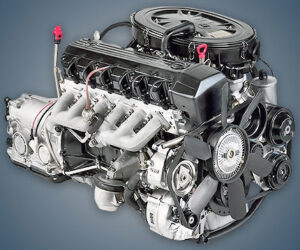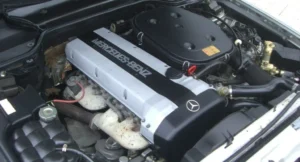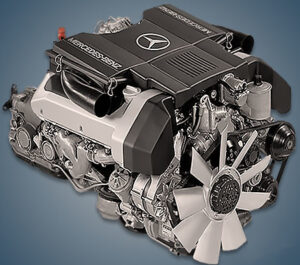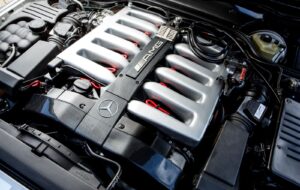Mercedes: The evolution of engines
1. Mercedes R129 and Its engine innovations
3. The introduction of four-valve technology
5. The M119 V8
6. The promise of a V12 powertrain
7. Conclusion
Mercedes R129 and Its engine innovations
When Mercedes-Benz introduced the R129 series, it marked a turning point in the company’s engineering approach. The car’s design was a blend of tradition and modernity, and the same could be said for its powertrain selection. While maintaining tried-and-tested engine foundations, Mercedes introduced groundbreaking innovations that enhanced performance, efficiency, and reliability.
The familiar M103 engine
For the European market, where emissions regulations were relatively lenient compared to the United States and Japan, Mercedes-Benz continued using the M103 engine. This 3.0-liter inline-six had its roots in the previous 300SL, tracing its lineage back to the 1950s and 1960s. Retaining a cast-iron block but incorporating a modern aluminum alloy cross-flow cylinder head, the M103 (Type 103.984) featured a single overhead camshaft with hydraulic lifters. These enhancements reduced wear and noise, improving overall durability and refinement.
The M103 also benefited from electronic ignition (EZL) and Bosch’s KE-Jetronic fuel injection system. With a 9.2:1 compression ratio, improved catalytic converters, and optimized combustion chamber design, it produced 190 horsepower. This was a modest but notable increase over its predecessor, making it a well-rounded choice for performance and efficiency.
The introduction of four-valve technology
The true innovation came with the introduction of four-valve-per-cylinder engines, an approach that was gaining traction in the automotive world. While Mercedes-Benz had experimented with this technology in racing as early as the pre-World War I era, it wasn’t until the 1984 190E 2.3-16 that it made its way into production cars. The advantage of four-valve technology lay in improved airflow, allowing for increased power output, smoother combustion, and reduced emissions.
To optimize the torque curve for real-world driving, Mercedes implemented Variable Valve Timing (VVT), which adjusted valve timing based on engine load and RPM. This innovation helped enhance low-end and mid-range torque while also improving efficiency and emissions.
The M104 inline-six
The M104 engine was the next step in the evolution of Mercedes-Benz’s inline-six lineup. Although initially developed for the W124 mid-size sedan, it debuted first in the R129 SL model. This 3.0-liter unit retained the cast-iron block and bore/stroke dimensions of its M103 predecessor but introduced a lightweight aluminum cylinder head. Featuring dual overhead camshafts (DOHC) and 24 valves, the M104 improved combustion efficiency and power delivery.
With a 10.0:1 compression ratio and advanced knock-sensor technology working alongside Bosch KE5 engine management, the M104 produced 231 horsepower—41 horsepower more than the M103—while maintaining nearly the same fuel consumption. It was a significant step forward, offering greater responsiveness and a more refined driving experience.
The M119 V8
Replacing the aging M117 V8, the M119 brought modern engineering into the 500SL. While still an all-aluminum design, the biggest advancement was its switch from a single overhead camshaft per bank to a DOHC setup with four valves per cylinder. Mercedes engineers also refined the lubrication system, strengthened the crankcase, and enhanced the exhaust design for improved efficiency.
The M119 V8 produced a minimum of 326 horsepower and 332 lb-ft of torque, making the 500SL the most powerful model in the Mercedes-Benz lineup at the time. It also featured the familiar KE-Jetronic fuel injection system and EZL ignition, with two distributors—one per cylinder bank—for optimal performance.
The promise of a V12 powertrain
Mercedes-Benz had been developing a V12 engine for years, largely in response to competition from BMW and Jaguar. With a displacement of 6.0 liters, this engine was designed to deliver nearly 400 horsepower while maintaining smoothness and efficiency. Featuring four valves per cylinder and Variable Valve Timing, it aimed to provide effortless performance with reduced emissions.
However, development delays meant the 600SL did not debut with the initial R129 lineup. Instead, it was officially introduced to the public on July 13, 1992, bringing the ultimate expression of luxury and performance to the SL range.
Conclusion
The R129 series marked a transformative period for Mercedes-Benz. With advancements in engine technology, emissions control, and performance optimization, the brand set new benchmarks in engineering excellence. Whether through the familiar M103, the revolutionary M104, the powerful M119, or the aspirational V12, Mercedes-Benz ensured that the R129 SL lineup remained at the forefront of automotive innovation.
Are you already a proud owner of a Mercedes R129? If so, check out our selection of parts for this car at the following link:
Photos sources: mymotorlist.com, car-community.blog, autoevolution.com, mercedes-benz-slovenija.com











